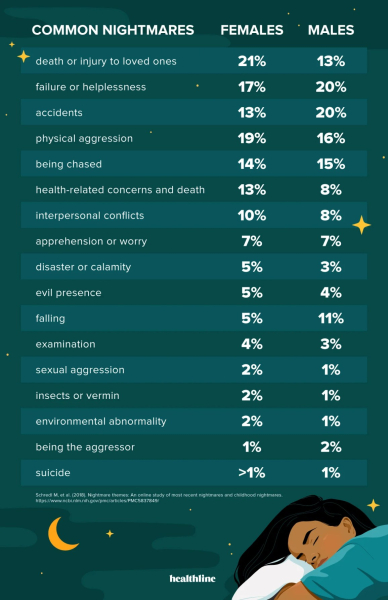While no one is exactly sure why we have nightmares, research shows they’re more common in those with some mental health diagnoses, such as post-traumatic stress disorder (PTSD).
Falling from a high place, being chased by a vicious animal, wandering around lost or helpless… what do all these things have in common? If you hadn’t already guessed it, the scenarios are just a few of the most common themes that people report experiencing in their nightmares. But what do these nightmares actually mean — and can they be a warning sign that something is wrong?
Ahead, we’ll explore what you need to know about the most common nightmares, including when chronic nightmares may be a potential sign of a larger health issue.
What are the most common nightmares?
Nightmares, like dreams, can come in all shapes and sizes – but as it turns out, there are a few common themes that people seem to grapple with when they experience nightmares.
One study from 2018 published in the Journal of Clinical Sleep Medicine explored the most common nightmare themes in more than 1,200 participants. The results of the study found several common themes among those experiencing frequent nightmares:
- 19% — death or injury to loved ones
- 18% — failure or helplessness
- 18% — physical aggression
- 15% — accidents
- 14% — being chased
- 11% — health-related concerns or death
Interestingly, the results of the study also found several differences in nightmare themes between sexes. For example, more females reported experiencing themes such as physical aggression and health-related concerns, while more males reported nightmares about helplessness and accidents.
 Infographic by Bailey Mariner
Infographic by Bailey Mariner
Another survey from Amerisleep explored specific nightmares in 2,000 survey respondents and found similar results. According to its survey, the two most frequently reported nightmares were falling and being chased. More than 50% of survey respondents also reported frequently having nightmares about death, feeling lost, and feeling trapped.
Results of the survey above also found significant differences between the dreams reported by men and women, especially when related to death. In this survey, more than 60% of women reported having nightmares about a loved one passing versus only 39% of men. Women were also more likely to have nightmares about being visited by a deceased family member or friend (64.3% versus 35.6%).
Can nightmares be warnings?
Researchers still have a lot to learn about the science of dreaming, and there are multiple theories as to why we dream. For example, the psychodynamic theory of dreams says that dreams simply exist to fulfill our subconscious desires. And the neurocognitive theory says that dreams are merely a byproduct of the brain’s natural evolution.
None of the theories about dreaming point to our dreams (or nightmares) as being warnings of potential or impending doom. However, there’s one thing that nightmares may actually “warn” us about: our physical and mental health.
According to research, nightmares are more common in people who have mental health diagnoses. In fact, one study states that up to 70% of people with PTSD, major depression, and other mental health diagnoses experience chronic nightmares. A condition called nightmare disorder, specifically, appears to affect a large percentage of people living with mental health conditions.
It’s not just mental health disorders that can cause an increase in nightmares, either. One study found that nightmares are also commonly associated with other factors such as negative feelings, worry, and sleep duration. Research also suggests that certain health conditions, such as migraine and asthma, and certain medications can cause an increase in nightmares.
How does your brain decide what to dream?
It’s hard to say exactly how our brains decide what to dream about each night — or if we’ll even dream at all. But for the most part, researchers believe that our dreams are strongly influenced by factors such as our personality and imagination, as well as the things we’re interested in and concerned about.
In children, for example, dreams tend to follow cognitive development and become more involved as they get older. And in adults, things such as mood and mental health can greatly influence the content of our nightly dreams.
However, the truth is that most people don’t have any conscious control over what they dream about. Our brain subconsciously creates dreams and nightmares for us, and we’re still learning how and why. In other words, when it comes to dreaming, we’re just along for the ride.
How to get better sleep
If you’ve been having trouble sleeping lately, here are five sleep hygiene tips that you can follow to improve your nightly rest:
- Get more sunlight: Sunlight helps your body regulate its sleep-wake cycle, so getting more sunlight during the day can help your body recognize when it’s time to sleep.
- Lower caffeine intake: Caffeine can be incredibly disruptive to sleep. Try to avoid consuming any caffeine for at least 6 to 8 hours before you plan to head to bed.
- Avoid long midday naps: Short naps during the day can be beneficial, but you should avoid longer midday naps if you want your body to stay tired when bedtime arrives.
- Revamp your bedroom: Ensuring that you have a comfortable bedroom with the right bedding, lighting, and temperature can help you sleep better during the night.
- Consider seeing a doctor: If you’ve tried to make changes to your sleep routine and are still having trouble sleeping, consider discussing your concerns with a doctor.
And if you’re interested in learning more about the science behind good sleep, our sleep hub features plenty of tips, tricks, and resources for better sleep.
The takeaway
Most people experience nightmares from time to time, and for the majority of people, they’re usually nothing to worry about.
However, some people — especially those with certain underlying physical or mental health conditions — may experience nightmares more frequently than usual. If you’ve been experiencing frequent or chronic nightmares, consider reaching out to a doctor to discuss your concerns.




